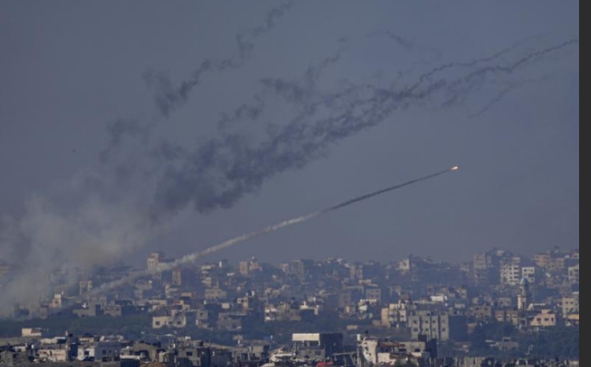Israeli airstrikes on Gaza resume after weeklong truce with Hamas ends
KHAN YOUNIS, Gaza Strip (AP) — Israel’s war with Hamas resumed in full force Friday, as airstrikes hit houses and buildings in the Gaza Strip minutes after a weeklong truce expired. Black smoke billowed from the besieged territory, where health authorities reported dozens of Palestinians killed and Israel dropped leaflets over Gaza City and southern parts of the enclave, urging civilians to flee to avoid the fighting.
In Israel, sirens warned of incoming rockets at several communal farms near Gaza, where militants took credit for launching attacks.
The resumption of the war threatens to compound the suffering in Gaza. Some 2 million people — almost its entire population — are crammed into the territory’s south, where Israel urged people to relocate at the start of the war and has since vowed to extend its ground assault. Unable to go into north Gaza or neighboring Egypt, the only escape for people is to move around within the 85-square-mile area (220 square kilometers).
Renewed hostilities also heighten concerns for about 140 hostages still held captive there by Hamas and other militants, after more than 100 were freed during the truce.
Qatar, which has served as a mediator along with Egypt, said negotiators were still trying to reach an agreement on restarting the cease-fire. Israel and Hamas traded blame for ending the truce, but Qatar’s Foreign Ministry singled out Israel’s role in the resumption of fighting, saying it “complicates mediation efforts and exacerbates the humanitarian catastrophe.”
A day earlier, U.S. Secretary of State Antony Blinken met with Israeli officials and urged them to do more to protect Palestinian civilians as they seek to destroy Hamas. Blinken arrived Friday at global climate talks in Dubai, where he was to meet with Arab foreign ministers and other officials.
Advertisement
It was not clear to what extent Israeli Prime Minister Benjamin Netanyahu will heed the appeals of the United States, Israel’s most important ally.
Netanyahu’s office said Friday that Israel “is committed to achieving the goals of the war: releasing the hostages, eliminating Hamas and ensuring that Gaza never again constitutes a threat to the residents of Israel.” Hamas has ruled Gaza since 2007.
In response to the U.S. calls, the Israeli military released a map dividing the Gaza Strip into hundreds of numbered, haphazardly drawn parcels. It asked residents to learn the number associated with their location in case of an eventual evacuation.
It was not immediately clear how Palestinians would be updated on evacuation calls or where they would go, with no safe areas designated on the map.
Only hours into the renewed bombardment, Gaza’s Health Ministry said 109 people had been killed and dozens wounded. Israel said it struck more than 200 Hamas targets.
Since the war began, more than 13,300 Palestinians have died, roughly two-thirds of them women and minors, according to Gaza’s Health Ministry, which does not differentiate between civilians and combatants.
The toll is likely much higher, as officials have only sporadically updated the count since Nov. 11. The ministry says thousands more people are feared dead under the rubble.
The war began after the Oct. 7 attack by Hamas and other Palestinian militants, who killed about 1,200 people, mostly civilians, in southern Israel and took around 240 people captive.
RETURN TO BATTLE
About an hour before the cease-fire was to expire early Friday, Israel said it intercepted a volley of rockets fired from Gaza. Minutes after the deadline, the military announced a resumption of combat operations and soon after gave word of new strikes.
In the leaflets it dropped in southern Gaza, Israel urged people to leave homes east of Khan Younis, warning that the southern town was now a “dangerous battle zone.” Other leaflets warned residents of several neighborhoods in Gaza City in the north to move south.
Hundreds of thousands of people fled northern Gaza earlier in the war, in an extraordinary mass exodus that saw many take shelter in Khan Younis and other places in the south.
One of the first airstrikes Friday destroyed a large building in Khan Younis. Moments later, residents were seen frantically searching the rubble for survivors as medics approached. One wounded person was carried away on a stretcher.
“We are women and children here. We have nothing,” said Fatima Nshasi, a relative of a family in the building, as women sobbed nearby. “We were going with life as usual and hoping that the truce would be extended.”
In Hamad City, a Qatari-funded housing development near the city, a strike hit an apartment in a multistory residential building, while other parts of the building appeared largely intact.
Elsewhere, a strike hit a home near Gaza City in the north, and in the refugee camp of Maghazi, in central Gaza, rescuers clawed through the rubble of a large building hit by warplanes. A foot stuck out of the tangle of concrete and wiring.
Israel has said it is targeting Hamas operatives and blames civilian casualties on the group, accusing the militants of operating in residential neighborhoods. Israel says 77 of its soldiers have been killed in the ground offensive. It claims to have killed thousands of militants, without providing evidence.
In Israel, white smoke trails could be seen in the skies over Sderot on the border with northern Gaza after Israel’s missile protection systems activated.
COLLAPSED TRUCE
Netanyahu said Hamas had violated the terms of the truce. “It has not met its obligation to release all of the women hostages today and has launched rockets at Israeli citizens,” he said in a statement.
Hamas blamed Israel, saying in a statement that it had rejected all offers Hamas made to release more hostages and bodies of the dead. Senior Hamas official Osama Hamdan told The Associated Press in Beirut that Hamas refused to an Israeli list of 10 female hostages to release because they were soldiers seized at military posts.
Hamas was expected to set a higher price for releasing Israeli soldiers and male hostages. The fact that few women and children hostages remain in Gaza made talks for a further extension of the cease-fire tougher.
Netanyahu has been under intense pressure from families of the hostages to bring them home. But his far-right governing partners have also pushed him to continue the war until Hamas is destroyed, and could abandon his coalition if he is seen as making too many concessions.
During the truce, which began Nov. 24, Hamas and other militants in Gaza released more than 100 hostages, most of them Israelis, in return for 240 Palestinians freed from prisons in Israel. Virtually all of those freed were women and children.
A total of 81 Israelis, including dual nationals, were freed during the truce. Another 24 hostages — 23 Thais and one Filipino — were also released, including several men.
The 240 Palestinians released were mostly teenagers accused of throwing stones and firebombs during confrontations with Israeli forces. Several were women who were convicted by military courts of attempting to attack soldiers.
Source: Associated Press



